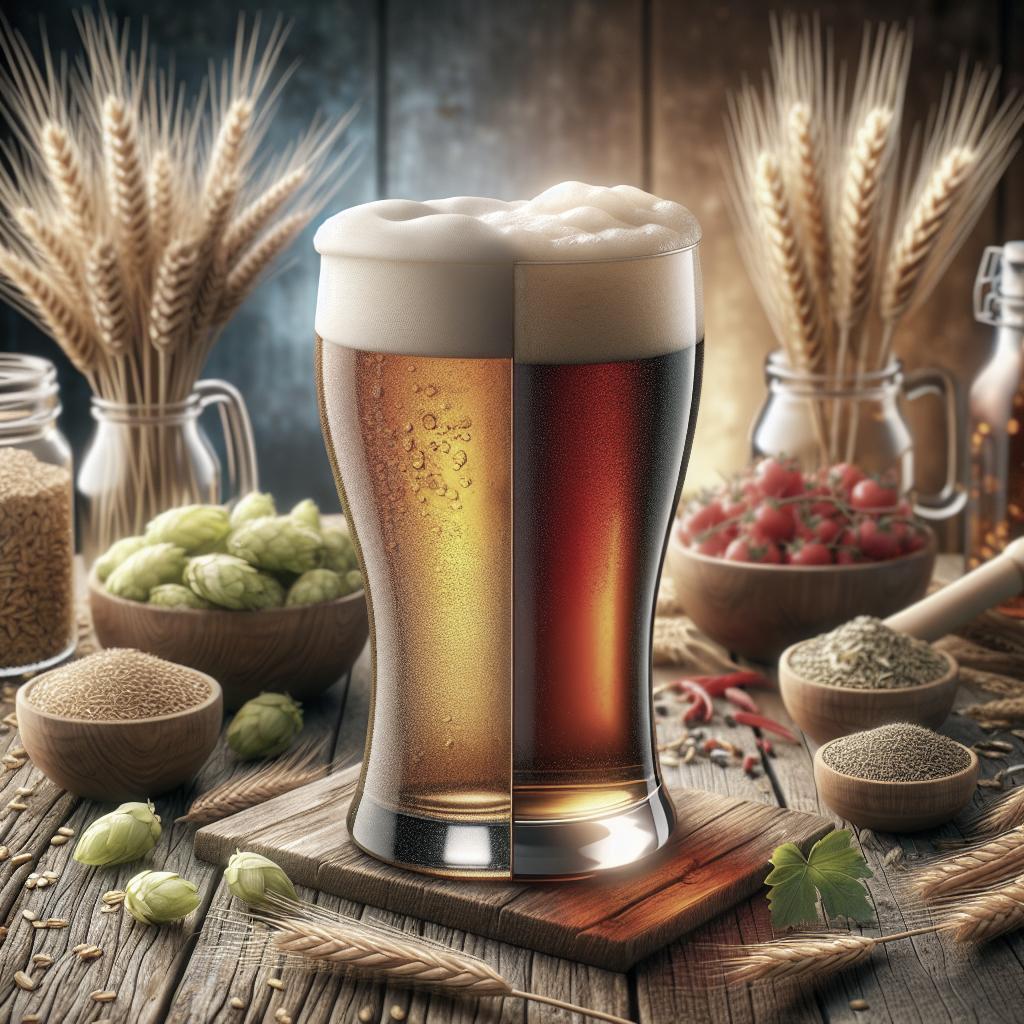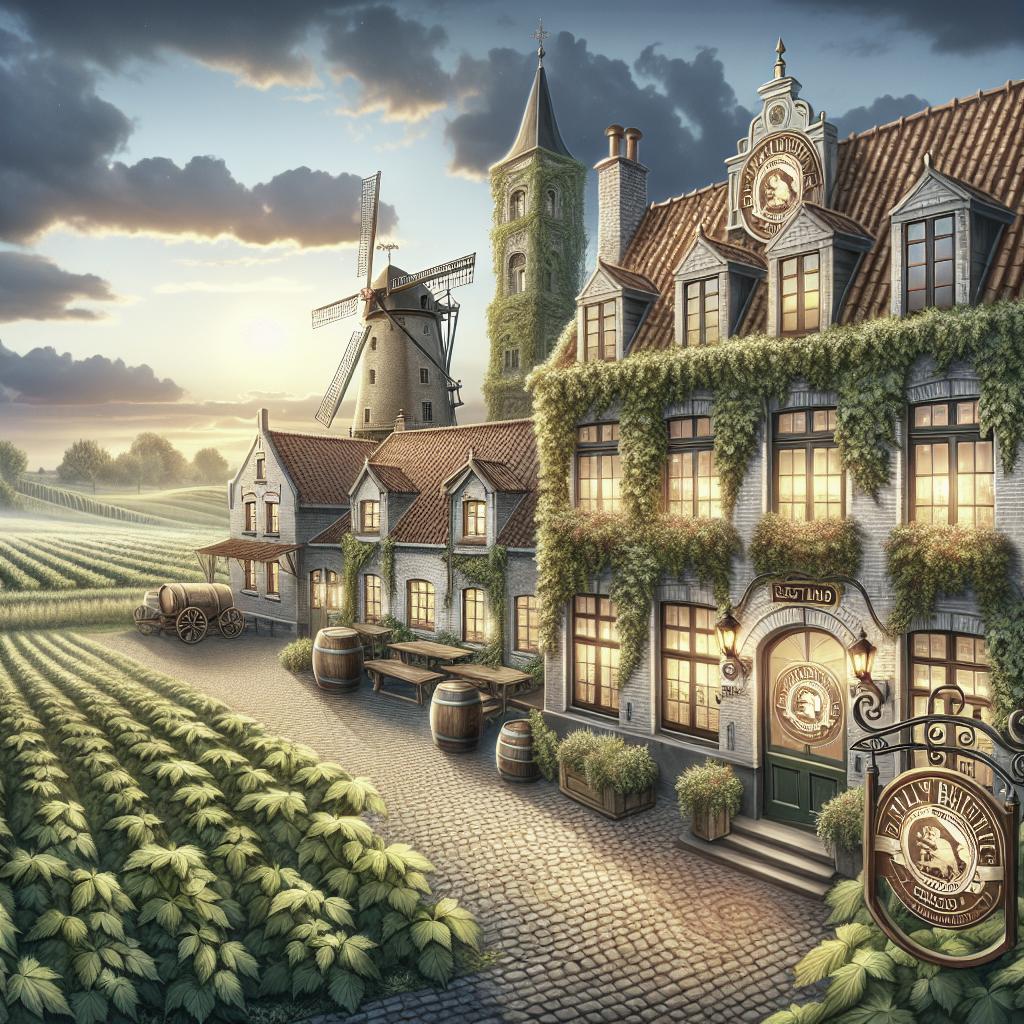“`html
Pilsner vs. Belgian Ale: Exploring the Diverse World of Beer
In the vast and diverse universe of beer, Pilsners and Belgian Ales each hold a significant place. Pilsners, originating from the Czech Republic, are lauded for their crisp, refreshing character. On the other hand, Belgian Ales are celebrated for their rich flavors and the cultural tradition surrounding their brewing. This post will delve into the different types of Belgian Ales, from Abbey to Sour Ales, and explore their unique characteristics and brewing techniques. Understanding these differences will not only enhance your appreciation of these brews but will also guide you in choosing the perfect beer for any occasion.
Abbey Ales
Abbey Ales are often associated with monastic brewing traditions, though not necessarily produced within monastery walls. These ales are known for their depth of flavor and history, often inspired by the practices of Trappist monks. Notably, Abbey Ales are typically lower in alcohol content than their Trappist counterparts, making them more accessible to a wider audience.
The brewing process for Abbey Ales often involves carefully selected yeasts that provide fruity and spicy notes, a hallmark of Belgian beer flavors. These ales offer a unique, comforting earthiness that can accompany anything from a heartwarming stew to a sophisticated cheese platter. As rich in character as the historical settings they emulate, Abbey Ales showcase the skillful art of Belgian brewing.
Dubbel, Quadrupel, and Belgian Strong Dark Ale
Perhaps one of the most revered styles of Belgian Ale, the Dubbel is characterized by its dark color and robust malt flavors. This ale generally has a medium to heavy body with rich caramel and toasted malt undertones. Originating from Belgium’s monasteries, Dubbels frequently feature a range of fruity esters and a touch of phenolic spice.
Quadrupels, or Quads, take the rich malt profile of Dubbels even further. These high-gravity ales are celebrated for their complex flavor profiles, ticking off characteristics such as figs, caramel, and even hints of rum-like alcohol warmth. The strength of Quads, often topping 10% ABV, makes them perfect for slow sipping as a dessert beer.
Belgian Strong Dark Ales can sometimes overlap with Dubbels and Quads but are generally noted for even more complexity, with deep, layered flavors that balance sweetness and roasted malt bitterness. These are ales to be savored, often maturing beautifully with age.
Tripel
Tripels offer a fascinating contrast to the darker Belgian styles with their golden hue and elevated alcohol content. The brewing of a Tripel involves a substantial amount of pale malts and is often boosted by the addition of sugars, allowing the yeast to ferment at higher alcohol levels while maintaining a lighter body.
The distinctive flavors of a Tripel include spice, which is often accentuated with the creative use of hops, and notes of honey and citrus. This ale is bright, and complex yet incredibly balanced, making it a delightful choice for those seeking strength but desiring a lighter, effervescent brew.
Farmhouse Ales
Farmhouse Ales, traditionally brewed on farms in Wallonia, Belgium, were originally intended to refresh and nourish seasonal workers. These ales have an enchanting rusticity, often including seasonal herbs or spices and showcasing the terroir of the area in which they are brewed.
The yeast used in Farmhouse Ales contribute to their unique flavor profile, adding elements such as peppery, earthy, or even slightly sour notes. Each brewer’s interpretation can vary significantly, contributing to the diversity and intrigue of this style.
Saison and Bière de Garde
Saison, a sub-style of Farmhouse Ales, have become world-renowned for their dry, fruity, and peppery notes, with a slight tartness that quenches thirst with complexity. These ales are often highly carbonated, making them wonderfully refreshing.
Bière de Garde, on the other hand, originate from Northern France, with the name translating to “beer for keeping”. Traditionally brewed in winter and spring, these ales are stored and matured for consumption in warmer months. Unlike Saisons, Bière de Garde tend to offer a more malty sweetness with rustic earth tones.
Other Belgian Ales
Belgian ales are not restricted to the classic Abbey and Farmhouse types. The Belgian beer scene is one of innovation and tradition, leading to many unique and hybrid styles. These can range from barrel-aged curiosities to beer brewed with fruit and spices not typical in other regions.
The experimentation within Belgian brewing is endless, resulting in a vast catalog of unique offerings, from spiced Christmas beers to modern Belgian IPAs. Regardless of the specific brew, each Belgian Ale is deeply rooted in the country’s rich culture of craftsmanship and conviviality.
Belgian Strong Pale Ale and Belgian Blonde
Belgian Strong Pale Ales pack a punch with their high alcohol content while delivering a light, crisp body. These golden ales feature a well-balanced hop bitterness and can have notes ranging from tropical to earthy, making them ideal for those who appreciate the subtleties of a complex hop profile.
Belgian Blonde Ales are often enjoyed as an introduction to Belgian beer. These ales are known for their golden color, smooth malt backbone, and a gentle sweetness often finishing with a hint of honey. Less intense than tripels, they offer accessibility without forgoing complexity.
Belgian Pale Ale
Belgian Pale Ales simplify the drinking experience while retaining the distinctive Belgian yeast character. These ales are marked by subtle hop bitterness and moderate maltiness, making them a perfect beer for diverse palates.
Ideal for session drinking, Belgian Pale Ales typically feature lower alcohol content than their stronger Belgian counterparts, making them suitable for casual occasions yet still providing a depth of flavor that stands out against the average pale ale.
Witbier
Witbier, or white beer, is an iconic Belgian style renowned for its hazy appearance and refreshing character. Traditionally brewed with a portion of wheat, Witbiers incorporate coriander and orange peel, creating a zesty and aromatic profile perfect for summer.
The light body and moderate alcohol content make Witbier an excellent choice for those seeking a sessionable beer that packs a flavorful punch. Its effervescence and brisk finish pair well with a variety of foods, from seafood to light pastas.
Sour Ales
Sour ales occupy a revered place in Belgian brewing, known for their complex tart and tangy profiles. These beers undergo spontaneous fermentation, often involving wild yeasts and bacteria, which give them distinctive sour and fruity flavors.
These ales are a true testament to the art of brewing, as the fermentation process is left to time-honored methods that date back centuries. Sour ales can range from subtly tart to intensely sour, providing a spectrum of flavors that can captivate any adventurous palate.
Lambic and Gueuze
Lambics are a celebrated and traditional style of Belgian sour ale brewed through spontaneous fermentation. Distinctly Belgian, Lambics can be found aged with fruits, like cherries or raspberries, which impart rich colors and additional complexity to the brew.
Gueuze is a unique type of Lambic, created by blending young and aged Lambics, which is then bottle-conditioned. The end product features a champagne-like fizz and a nuanced balance of tartness, funk, and light sweetness.
Flanders Red and Flanders Brown
Flanders Red Ales are known for their striking reddish-brown color achieved through a long maturation period in oak barrels. The aging process introduces a harmonious blend of sour, fruity, and vinous notes, often compared to red wine.
Also known as Oud Bruin, Flanders Brown Ales share similarities with their red counterparts but are typically less tart. These ales offer a maltier profile with notes of caramel and raisin, often with a mild sweetness balanced by an acidic finish.
Next Steps
| Subheading | Description |
|---|---|
| Abbey Ales | Ale inspired by monastic traditions with fruity and spicy yeast notes. |
| Dubbel, Quadrupel, and Belgian Strong Dark Ale | Rich, malty beers with complex flavor profiles including figs and caramel. |
| Tripel | Golden ales with high alcohol content, featuring spice, honey, and citrus notes. |
| Farmhouse Ales | Rustic beers with potential seasonal ingredients and varied yeast character. |
| Saison and Bière de Garde | Saisons are dry and tart while Bière de Garde are malty and rustic. |
| Other Belgian Ales | Includes unique interpretations and modern hybrids from Belgian brewers. |
| Belgian Strong Pale Ale and Belgian Blonde | Light-bodied, high alcohol ales with intricate hop profiles. |
| Belgian Pale Ale | Subtle hop bitterness and moderate maltiness, perfect for session drinking. |
| Witbier | Hazy white beer brewed with coriander and orange peel for zestiness. |
| Sour Ales | Includes uniquely tart brews from natural fermentation processes. |
| Lambic and Gueuze | Specialty sour ales with natural fermentation and fruit infusions. |
| Flanders Red and Flanders Brown | Barrel-aged ales with wine-like qualities and varying tartness. |
“`


